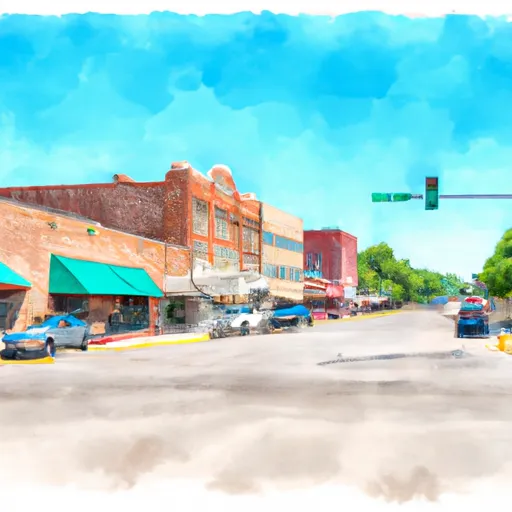-
 Snoflo Premium
Snoflo Premium
Get unlimited access to all our content
With no Ad interruptions! - Start Your Free Trial Login with existing account
Buffalo
Eden Index
Climate
8.3
•
Recreation
3.4
•
Community
0.7
•
Safeguard
4.7/10

Buffalo, Kansas is a small town located in Wilson County with a population of approximately 300. The climate in Buffalo is considered humid subtropical with hot summers and cold winters. The town is situated near the Verdigris River, which is the primary source of water for the area. The river is also a popular spot for fishing and boating. Buffalo also has several lakes and ponds, including Buffalo Lake, which offers swimming, boating, and camping opportunities. Outdoor enthusiasts can also explore the local wildlife areas and hiking trails, such as the Prairie Spirit Trail State Park. The hydrology constituents in Buffalo are primarily focused on water conservation and management, as the area is prone to droughts during the summer months.
What is the Eden Index?
The Snoflo Eden Index serves as a comprehensive rating system for regions, evaluating their desirability through a holistic assessment of climate health, outdoor recreation opportunities, and natural disaster risk, acknowledging the profound impact of these factors on livability and well-being.
Climate Health Indicator (CHI): 8.3
Buffalo receives approximately
1038mm of rain per year,
with humidity levels near 84%
and air temperatures averaging around
14°C.
Buffalo has a plant hardyness factor of
6, meaning
plants and agriculture in this region thrive during a short period during spring and early summer. Most
plants will die off during the colder winter months.
By considering the ideal temperature range, reliable water supplies, clean air, and stable seasonal rain or snowpacks, the Climate Health Indicator (CHI) underscores the significance of a healthy climate as the foundation for quality living.
A healthy climate is paramount for ensuring a high quality of life and livability in a region, fostering both physical well-being and environmental harmony. This can be characterized by ideal temperatures, reliable access to water supplies, clean air, and consistent seasonal rain or snowpacks.
Weather Forecast
Streamflow Conditions
Verdigris
Area Rivers
Verdigris
Snowpack Depths
Verdigris
Reservoir Storage Capacity
Verdigris
Groundwater Levels
Recreational Opportunity Index (ROI): 3.4
The Recreational Opportunity Index (ROI) recognizes the value of outdoor recreational options, such as parks, hiking trails, camping sites, and fishing spots, while acknowledging that climate plays a pivotal role in ensuring the comfort and consistency of these experiences.
Access to outdoor recreational opportunities, encompassing activities such as parks, hiking, camping, and fishing, is crucial for overall well-being, and the climate plays a pivotal role in enabling and enhancing these experiences, ensuring that individuals can engage in nature-based activities comfortably and consistently.
Camping Areas
| Campground | Campsites | Reservations | Toilets | Showers | Elevation |
|---|---|---|---|---|---|
| Michigan Valley - Pomona Reservoir | 95 | 998 ft | |||
| Pomona State Park | 370 | 1,023 ft | |||
| Outlet Park - Pomona Reservoir | 35 | 980 ft | |||
| Eisenhower State Park | 230 | 1,082 ft | |||
| Turkey Point - Melvern Lake | None | 1,075 ft | |||
| Afton Landing - Chouteau Lake | None | 523 ft | |||
| Newt Graham Lock and Dam - Arkansas River | None | 521 ft | |||
| Big Creek Ramp - Oologah Lake | None | 653 ft | |||
| Arrow Rock - Melvern Reservoir | None | 1,087 ft | |||
| Bluff Landing - Arkansas River | None | 539 ft |
Nearby Fishing
Catastrophe Safeguard Index (CSI):
The Catastrophe Safeguard Index (CSI) recognizes that natural disaster risk, encompassing floods, fires, hurricanes, and tornadoes, can drastically affect safety and the overall appeal of an area.
The level of natural disaster risk in a region significantly affects safety and the overall livability, with climate change amplifying these risks by potentially increasing the frequency and intensity of events like floods, fires, hurricanes, and tornadoes, thereby posing substantial challenges to community resilience and well-being.
Community Resilience Indicator (CRI): 0.7
The Community Resilience Indicator (CRI) recognizes that education, healthcare, and socioeconomics are crucial to the well-being of a region. The CRI acknowledges the profound impact of these elements on residents' overall quality of life. By evaluating educational resources, healthcare accessibility, and economic inclusivity, the index captures the essential aspects that contribute to a thriving community, fostering resident satisfaction, equity, and social cohesion.

